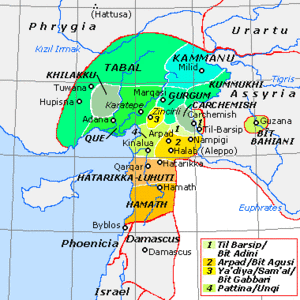Luhuti
Luhuti Lukhuti - Lu'ash | |||||||||
|---|---|---|---|---|---|---|---|---|---|
| Unknown–737 BC | |||||||||
 Luhuti (Luash) Location, Showing The Capital (Afis) | |||||||||
| Capital | Hatarikka (Afis) | ||||||||
| Common languages | Aramaic | ||||||||
| Religion | Levantine Religion | ||||||||
| Government | Unknown | ||||||||
| Historical era | Iron Age | ||||||||
• Established | Unknown | ||||||||
• Disestablished | 737 BC | ||||||||
| |||||||||
| Today part of | |||||||||
Luhuti,Lukhuti or Lu'ash, was an Iron Age Syro-Hittite Aramean region during the early 1st millennium BC located in northern Syria, in an area that used to be called Nuhašše.[1]
Political Situation and Capital
Luhuti was a region of unknown political status, its known primarily from Assyrian inscriptions,[1] and the stele of Zakkur king of Hamath,[2] however it's never attested as a kingdom or having a central authority,[3] although it did constitute an independent interconnected region which is obvious by the Assyrian inscriptions that describe luhuti as a country with many cities and troops.[4]
Luhuti had many cities, Shuksi was the maritime center,[5] But the most important center and capital was the city of Hazrik (modern Tell Afis, Known as Hatarikka for the Assyrians),[6][7] located 45 kilometer south of Aleppo.[8]
History

Luhuti was first attested in 870 BC, it was mentioned in the inscriptions of Ashurnasirpal II who conquered it after subduing Pattin using the patinite city of Aribua as his military base for operations against Luhuti,[4] Ashurnasirpal devastated the country, he mentions the impalement of Luhuti troops and the capture of its cities.[4]
By 796 BC Luhuti was incorporated to Hamath,[6] it formed the northern province of the kingdom,[6] king Zakkur of Hamath titled himself King of Hamath and Luhuti,[9] he was besieged in Hatarikka by a coalition of Syrian kings incited by Ben-Hadad III of Aram-Damascus,[10] and led by a king descended from Gusi identified as the king of Bit Agusi,[11] Zakkur survived the siege and commemorated the event by commissioning the Stele of Zakkur.[12]
Luhuti was attacked by Shalmaneser IV in 765 BC and Ashur-dan III in 755 BC, it was finally incorporated to Assyria as a province by Tiglath-Pileser III in 737 BC.[6]
Royal Family Hypothesis
Hittitologists Trevor R. Bryce and especially John David Hawkins believes Zakkur to be a usurper,[13] in his stele, Zakkur doesn't mention any royal ancestors, Hawkins believe's that Zakkur was an Aramean usurper local to Luhuti who replaced the old Hittite dynasty ruling in Hamath.[13]
References
Citations
- ^ a b John David Hawkins. Inscriptions of the Iron Age: Part 1. p. 400.
- ^ John Boardman. The Cambridge Ancient History: The prehistory of the Balkans; and the Middle East and the Aegean world, tenth to eighth centuries B.C.. Volume 3. Part 1. p. 499.
- ^ Kenneth Anderson Kitchen. On the Reliability of the Old Testament. p. 505.
- ^ a b c Trevor Bryce. The World of The Neo-Hittite Kingdoms: A Political and Military History. p. 132.
- ^ Claudia E. Suter, Christoph Uehlinger. Crafts and Images in Contact: Studies on Eastern Mediterranean Art of the First Millennium BCE. p. 133.
- ^ a b c d Trevor Bryce. The Routledge Handbook of the Peoples and Places of Ancient Western Asia. p. 296. Cite error: The named reference "bryce2" was defined multiple times with different content (see the help page).
- ^ I. E. S. Edwards, Cyril John Gadd, Nicholas Geoffrey Lemprière Hammondpage. The Cambridge Ancient History: Early History of the Middle East. Part 2, Volume 1. p. 282.
{{cite book}}: CS1 maint: multiple names: authors list (link) - ^ Holman Concise Bible Dictionary. p. 282.
- ^ David L. Petersen. Zechariah 9-14 and Malachi: A Commentary. p. 44.
- ^ John Boardman. The Cambridge Ancient History: The prehistory of the Balkans; and the Middle East and the Aegean world, tenth to eighth centuries B.C.. Volume 3. Part 1. p. 403.
- ^ Trevor Bryce. The World of The Neo-Hittite Kingdoms: A Political and Military History. p. 166.
- ^ James Maxwell Miller. A History of Ancient Israel and Judah. p. 303.
- ^ a b John David Hawkins. Inscriptions of the Iron Age: Part 1. p. 401.



